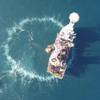Swedish Maritime Administration Using AI in Search and Rescue
All radio traffic on the emergency channel that reaches Sweden is now transcribed by artificial intelligence (AI) and shown to the operators at the Joint Rescue Co-ordination Centre in Gothenburg within a second. Keywords, such as "Mayday", "SOS", "help" and "sinking", are clearly marked and cannot be missed.
The Swedish Maritime Administration, together with the Swedish companies Tenfifty AB and Maranics AB, has conducted a research and innovation project during the past two years. Earlier this year, a full-scale test was launched of an emergency call detection system that uses the very latest AI technology. The system will be in operational use until the autumn when an evaluation will be made.
It was Tobias Nicander, rescue leader at the Joint Rescue Co-ordination Center, who already in 2009 came up with the idea of getting help with listening to the emergency channel. Calls can sometimes be difficult to interpret because the signals are weak and the messages are incoherent. In addition, there is always the risk that the operator is already working on an alarm when a new case arises. There is thus a small risk of missing a call, but by transcribing all calls, the risk is reduced. The technology did not exist when Tobias got the idea, but 10 years later, technology has caught up.
"Not only do we get the calls texted, we have also defined keywords that should be clearly marked and should remain on our screens until we say that we have seen them. We also receive documentation of what has been said on the channel, which can be helpful in improving the process in the future. It serves, for example, as a perfect base for education," Nicander said.
Already on the first day, the system drew the operators' attention to two "Mayday" calls: one in Germany and one in Denmark. This shows that the AI solution can interpret even weak signals and that the operators really get the help they want, to be able to make even better assessments in the future. In addition, it shows that the reach of the Swedish coastal radio network is good enough. The solution will not replace the operators. It is developed with the goal of relieving and supporting the operators in their daily work.











